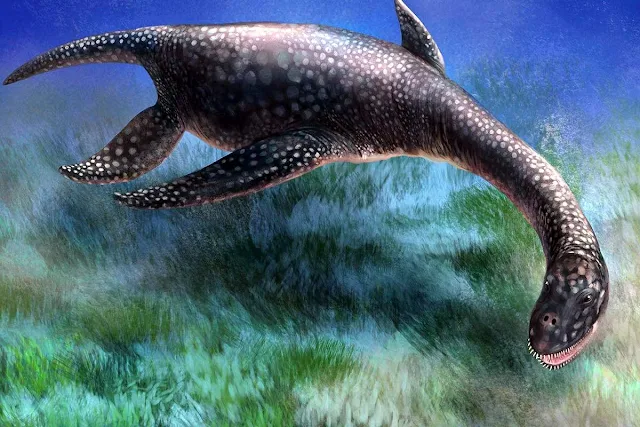Fossil of a 15 Ton Sea Creature Found in Antarctica
 |
| A hungry Aristonectes plesiosaur eyes a squid in this illustration. |
The prehistoric plesiosaur — a four-flippered marine reptile that lived during the dinosaur age — measured a colossal 36 feet (11 meters) long from snout to tail, about as long as a modern telephone pole. This newfound "sea monster" is now the largest known elasmosaurid (a type of plesiosaur with a long neck) on record.
It took decades of struggling with the weather on a small, desolate island off the Antarctic Peninsula. But now, scientists have finally unearthed the heaviest known elasmosaur, an ancient aquatic reptile that swam the seas of the Cretaceous period alongside the dinosaurs. The animal would have weighed as much as 15 tons, and it is now one of the most complete ancient reptile fossils ever discovered in Antarctica.
The team thinks the newly described heavyweight belongs to the genus Aristonectes, a group whose species have been seen as outliers to other elasmosaurs, since they differed so much from fossilized specimens discovered in the US. This genus, found in the Southern Hemisphere, is characterized by shorter necks and larger skulls.
"For years it was a mystery ... we didn't know if they were elasmosaurs or not," says José O'Gorman, a paleontologist with the National Scientific and Technical Research Council of Argentina who is based at the Museum of La Plata near Buenos Aires. "They were some kind of weird plesiosaurs that nobody knew."
"We don't have a skull, but we have a lot of pieces of the specimen," O'Gorman says. They estimate that the as-yet-unnamed elasmosaur weighed between 11.8 tons and 14.8 tons, with a head-to-tail length of nearly 40 feet. While some previously known Aristonectes have weighed about 11 tons or so, most other elasmosaurs only come in at around five tons.
He thinks the work is well done, and he's happy that the team hasn't jumped to hasty conclusions-O'Gorman even hesitates to say whether the species is definitely from the Aristonectes genus, since further evidence may put the species in a new genus entirely.
The new specimen is also very interesting because it dates so close to the end of the Cretaceous-just 30,000 years before the mass extinction event that wiped out the non-avian dinosaurs about 66 million years ago. A lot of marine life would have needed to thrive there to satisfy the appetite of such a large creature, so the fact that these animals continued to exist so late in the Cretaceous adds to the evidence that the aquatic world, at least, was doing just fine right up until the sudden mass extinction.
While the animal's exact diet can't be known without fossilized stomach contents or other evidence, O'Gorman says that it likely fed on crustaceans and small fish, based on the small size of its teeth. And work on the bones unearthed over the past few decades has just begun; now that they are housed in a museum, O'Gorman says there is a lot of other research that can be done on this ancient specimen.
The above story is based on materials provided by Argentina's National Antarctic Directorate.








